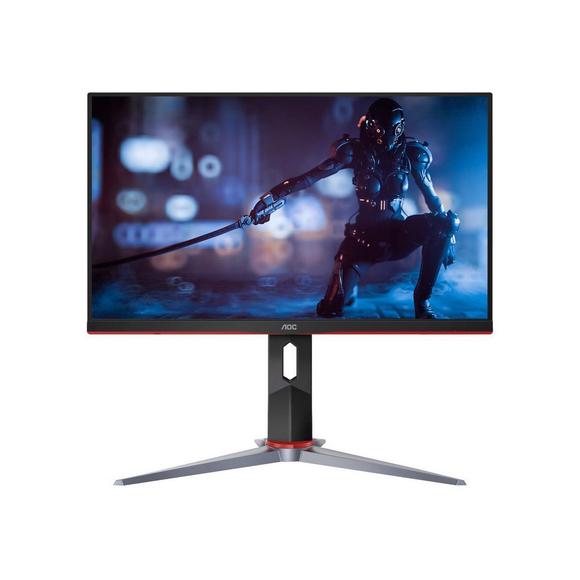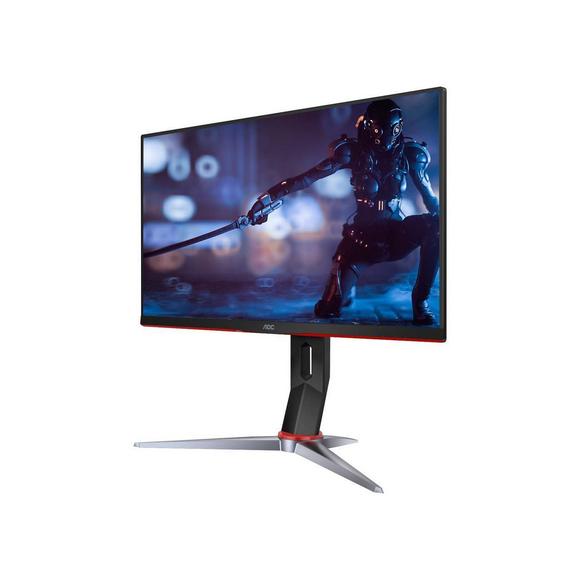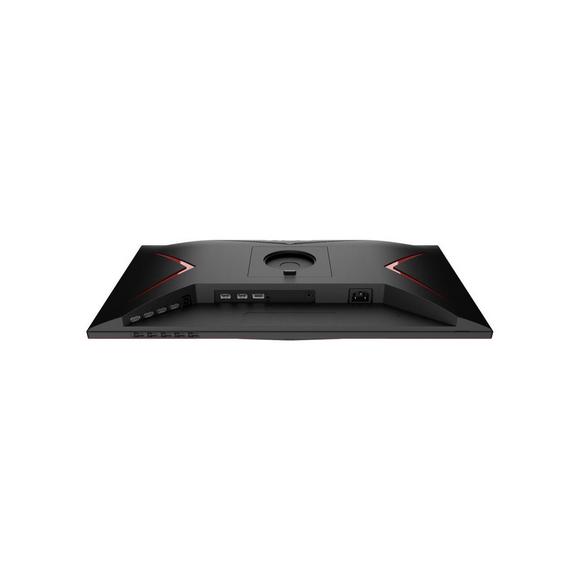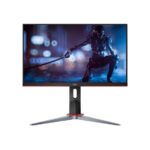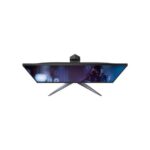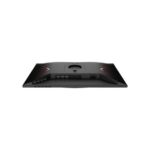AOC 27″ 27G2Z 240Hz IPS FHD FreeSync Premium 1920 x 1080 Gaming Monitor Price in Pakistan
| Brand
Name of the company-manufacturer. |
AOC |
| Model
Designation of the model. |
27G2Z |
| Model year
The year in which this model was announced. |
2022 |
Display
Information about the main characteristics of the display – panel, backlight, resolution, refresh rate, etc.
| Size class
Size class of the display as declared by the manufacturer. Often this is the rounded value of the actual size of the diagonal in inches. |
27 in (inches) |
| Diagonal
Approximate diagonal size of the display. If the manufacturer does not provide such information, the diagonal is calculated from the width and height of the screen. |
684.667 mm (millimeters) 68.4667 cm (centimeters) 26.9554 in (inches) 2.2463 ft (feet) |
| Width
Approximate width of the display. If the manufacturer does not provide such information, the width is calculated from the diagonal and the aspect ratio. |
596.736 mm (millimeters) 59.6736 cm (centimeters) 23.4935 in (inches) 1.9578 ft (feet) |
| Height
Approximate height of the display. If the manufacturer does not provide such information, the height is calculated from the diagonal and the aspect ratio. |
335.664 mm (millimeters) 33.5664 cm (centimeters) 13.2151 in (inches) 1.1013 ft (feet) |
| Panel type
There are various panel technologies. Each has its own specific features – viewing angles, color reproduction, response time, brightness/contrast, production cost, etc. The image quality depends directly on the type of the display panel used. |
IPS |
| Panel bit depth
The most widely used panels are those with 6, 8, and 10 bits for each of the RGB components of the pixel. They provide 18-, 24-, and 30-bit color, respectively. |
8 bits |
| Colors
The maximum number of colors, which the display is able to reproduce, depends on the type of the panel in use and color enhancing technologies like FRC. |
16777216 colors 24 bits |
| Aspect ratio
The ratio between the horizontal and the vertical side of the display. Some of the standard and widely used aspect ratios are 4:3, 5:4, 16:9 and 16:10. |
1.778:1 16:9 |
| Resolution
Information about the number of pixels on the horizontal and vertical side of the screen. A higher resolution allows the display of a more detailed and of higher quality image. |
1920 x 1080 pixels Full HD / 1080p |
| Pixel pitch
The pixel pitch shows the distance from the centers of two neighboring pixels. In displays, which have a native resolution (the TFT ones, for example), the pixel pitch depends on the resolution and the size of the screen. |
0.311 mm (millimeters) 0.0311 cm (centimeters) 0.0122 in (inches) 0.001 ft (feet) |
| Pixel density
Information of the number of pixels in a unit of length. With the decrease of the display size and the increase of its resolution, the pixel density increases. |
81 ppi (pixels per inch) 32 ppcm (pixels per centimeter) |
| Display area
The percentage of the approximate area, taken by the active part of the screen, to the total front area. |
89.4 % (percent) |
| Backlight
The backlight is the source of light of the LCD display panels. The type of backlight determines the image quality and the color space of the display. There are various backlights such as CCFL, LED, WLED, RGB-LED, and etc. |
W-LED |
| sRGB
sRGB is a color space, developed jointly by Hewlett-Packard and Microsoft in 1996. It is used in different devices such as printers, displays, TV sets, cameras, etc. The sRGB color space covers about 72% of the NTSC color space. |
115 % (percent) |
| NTSC (1953)
The NTSC (1953) color space is introduced in 1953 by the FCC with the appearance of color television and has a wider gamut than the sRGB. |
102 % (percent) |
| DCI P3
DCI P3 is a color space, introduced in 2007 by the SMPTE. It is used in digital cinema and has a much wider gamut than the sRGB. |
93 % (percent) |
| Brightness
Information about the brightness of the screen. It is measured in candela per square metre (cd/m²). |
400 cd/m² (candela per square meter) |
| Static contrast
The static contrast shows the ratio between the brightest and the darkest color, which the display can reproduce simultaneously, for example, within one and the same frame/scene. |
1000 : 1 |
| Dynamic contrast
The dynamic contrast shows the ratio between the brightest and the darkest color, which the display can reproduce over time, for example, in the course of playing a video. |
80000000 : 1 |
| HDR
HDR expands the contrast ratio (peak luminance and minimal black levels) and color palette to achieve more details across the whole image – from the darkest parts to the brightest ones, which results in more realistic and life-like image. |
DisplayHDR 400 |
| Horizontal viewing angle
Information about the maximum horizontal viewing angle, within which the image on the screen is of acceptable quality. |
178 ° (degrees) |
| Vertical viewing angle
Information about the maximum vertical viewing angle, within which the image on the screen is of acceptable quality. |
178 ° (degrees) |
| Minimum response time
Information about the minimum amount of time, in which the pixels change from one color to another. Very often the manufacturer provides the response time for transition from grey-to-grey (G2G). |
1 ms (milliseconds) 0.0010 s (seconds) |
| Coating
Information about the type of coating of the display. There are different types of matte and glossy coatings, each of which has its own advantages and drawbacks. |
Anti-glare/Matte (3H) |
| Response time – 0.5 ms (MPRT – Motion Picture Response Time) |
3D
3D displays use various technologies to achieve a 3D effect. Each of these technologies has its own advantages and drawbacks.
| 3D
Information on whether 3D is supported or not. |
No |
Frequencies
Information about the horizontal and vertical refresh rates/frequencies.
| Horizontal frequency (digital)
The horizontal scan rate/frequency shows the number of horizontal lines, displayed by the monitor per second, when it is plugged to a digital source. |
30 kHz – 255 kHz (kilohertz) |
| Vertical frequency (digital)
The vertical frequency/refresh rate shows how many times in a second the image on the screen is refreshed. |
48 Hz – 240 Hz (hertz) |
Power supply and consumption
Information about the power supply and consumption, energy efficiency class, etc.
| 110V
Permissible voltage tolerance in a 110-volt electric system. |
110 V – 120 V (volts) |
| 220V
Permissible voltage tolerance in a 220-volt electric system. |
220 V – 240 V (volts) |
| Alternating current frequency
Requirement regarding the alternating current frequency in the electric system. |
50 Hz – 60 Hz (hertz) |
| Electric current (A)
Requirement regarding the electric current rating in amperes (A) of the electric system. |
1.5 A (amperes) |
| Power consumption (off)
Power consumption in off-mode. |
0.3 W (watts) |
| Power consumption (sleep)
Power consumption in sleep/stand by/suspend mode. |
0.3 W (watts) |
| Power consumption (average)
Average power consumption in standard work mode. |
34 W (watts) |
Dimensions, weight and color
Information about the dimensions and the weight of the specific model with and without stand as well as the colors, in which it is offered to the market.
| Width
Width without stand in different measurement units. |
612.5 mm (millimeters) 61.25 cm (centimeters) 24.1142 in (inches) 2.0095 ft (feet) |
| Height
Height without stand in different measurement units. |
365.8 mm (millimeters) 36.58 cm (centimeters) 14.4016 in (inches) 1.2001 ft (feet) |
| Depth
Depth without stand in different measurement units. |
48.8 mm (millimeters) 4.88 cm (centimeters) 1.9213 in (inches) 0.1601 ft (feet) |
| Weight
Weight without stand in different measurement units. |
3.65 kg (kilograms) 8.05 lbs (pounds) |
| Width with stand
Width with stand in different measurement units. |
612.5 mm (millimeters) 61.25 cm (centimeters) 24.1142 in (inches) 2.0095 ft (feet) |
| Height with stand
Height with stand in different measurement units. |
398.6 mm (millimeters) 39.86 cm (centimeters) 15.6929 in (inches) 1.3077 ft (feet) |
| Depth with stand
Depth with stand in different measurement units. |
227.4 mm (millimeters) 22.74 cm (centimeters) 8.9528 in (inches) 0.7461 ft (feet) |
| Weight with stand
Weight with stand in different measurement units. |
4.98 kg (kilograms) 10.98 lbs (pounds) |
| Box width
Width of the package in different measurement units. |
730 mm (millimeters) 73 cm (centimeters) 28.7402 in (inches) 2.395 ft (feet) |
| Box height
Height of the package in different measurement units. |
520 mm (millimeters) 52 cm (centimeters) 20.4724 in (inches) 1.706 ft (feet) |
| Box depth
Depth of the package in different measurement units. |
187 mm (millimeters) 18.7 cm (centimeters) 7.3622 in (inches) 0.6135 ft (feet) |
| Box weight
Weight of the product with all accessories and packaging in different measurement units. |
7.31 kg (kilograms) 16.12 lbs (pounds) |
| Colors
Information about the colors, in which the specific model is offered to the market. |
Black and Gray with Red |
Ergonomics
Information about the ergonomic functions – height adjustment, swivel angles, tilt angles, etc.
| VESA mount
Information about whether there is a possibility for wall mounting according to the VESA Mounting Interface Standard (MIS). |
Yes |
| VESA interface
There are many various interfaces under the VESA standard, which differ in the size of the brackets, the distances between the screw holes and their number. |
100 x 100 mm |
| Removable stand
Information about whether the stand can be dismounted. Usually, this is required for wall mounting. |
Yes |
| Height adjustment
Information about whether the stand allows height adjustment. |
Yes |
| Height adjustment range
Information about the extent to which the stand allows the height to be adjusted. |
130 mm (millimeters) 13 cm (centimeters) 5.1181 in (inches) 0.4265 ft (feet) |
| Landscape/portrait pivot
Some displays have the ability to operate in landscape and portrait mode alike. |
Yes |
| Left pivot
Degree of pivoting the display counterclockwise. |
0 ° (degrees) |
| Right pivot
Degree of pivoting the display clockwise. |
90 ° (degrees) |
| Left/right swivel
Information whether the display can be swiveled around the stand axis. |
Yes |
| Right swivel
Maximum swivel degree of the display to the right of the stand axis. |
30 ° (degrees) |
| Forward/backward tilt
Most displays have the ability to be tilted forward and backward as to provide a more comfortable viewing position for the user. |
Yes |
| Forward tilt
Maximum degree of forward tilting of the display. |
5 ° (degrees) |
| Backward tilt
Maximum degree of backward tilting of the display. |
23 ° (degrees) |
Camera
Many contemporary desktop monitors and smart TV sets have built-in cameras.
| Camera
Information whether the current model has a built-in camera or not. |
No |
Connectivity
Available connectivity ports, slots and interfaces.
| Connectivity
Information about the available connectivity ports, slots and interfaces such as USB, infrared port, SD card slot, audio/video and network interfaces, etc. |
2 x HDMI 2.0 1 x DisplayPort 1.4 1 x 3.5 mm Audio Out |
Features
Some additional functional features of the model.
| Features
Information about additional software features, technologies, functions and services of the model. |
Adaptive-Sync technology AMD FreeSync Premium Dark Field Control Flicker-free technology Game Color HDR Mode Low Blue Light Motion Blur Reduction |
Certificates, standards and licenses
Licenses from regulatory agencies, standards, certificates.
| Certificates, standards and licenses
List of the standards, certificates and licenses supported/received by the current model. |
CB CCC CE CEL CH RoHS cTUVus FCC ISO 9241-307 MEPS RCM Win10 |
Accessories
Often the packaging of desktop monitors and smart TV sets includes accessories for them.
| Accessories
Information about some of the main accessories included in the standard packaging of the current model. |
DisplayPort cable |

 DRLR & Mirrorless
DRLR & Mirrorless Camera Lenses
Camera Lenses UV Filters
UV Filters Action Cameras
Action Cameras Backdrop & Support Kit
Backdrop & Support Kit Battery & Charger
Battery & Charger Camera Bags
Camera Bags


